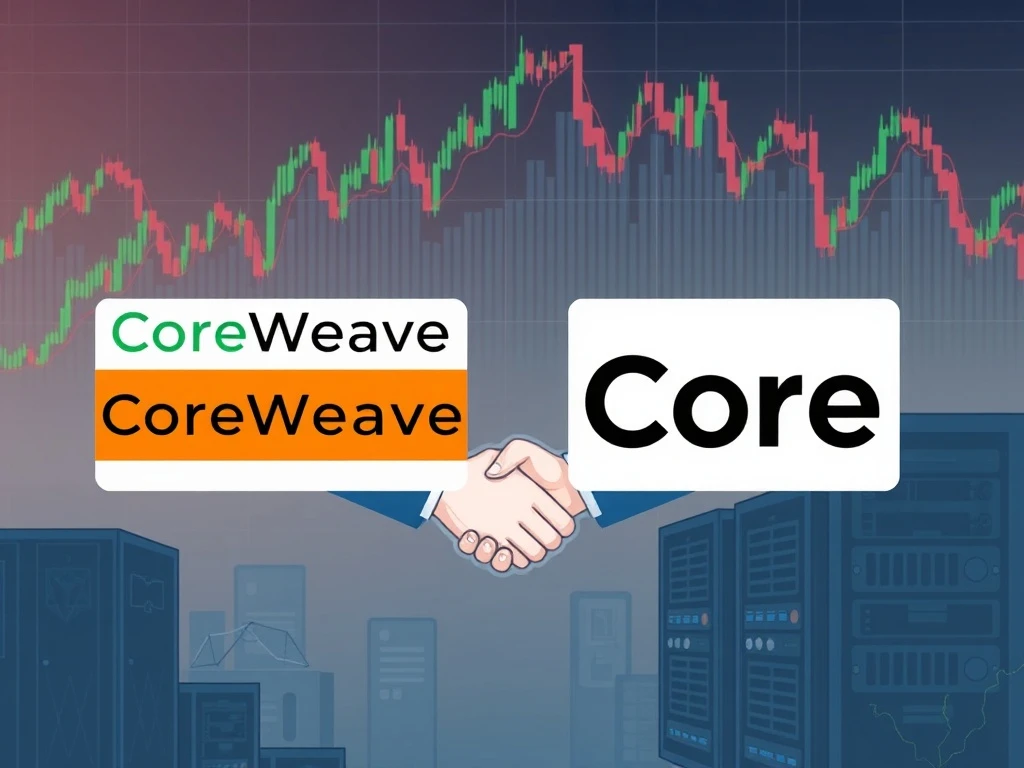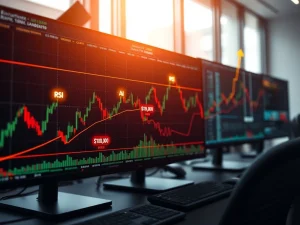CoreWeave’s Risky $9 Billion Core Scientific Acquisition Triggers Analyst Warnings as Stock Dips

The cryptocurrency and artificial intelligence sectors are no strangers to bold moves and market volatility. However, a recent development has sent ripples through both: CoreWeave’s audacious bid to acquire Core Scientific. This significant all-stock deal, valued at a staggering $9 billion, has immediately captivated market observers, sparking intense debate and leading to noticeable stock dips for CoreWeave shares. Is this a visionary leap into the future of AI infrastructure, or a high-stakes gamble with uncertain returns?
CoreWeave’s Bold Bet: Acquiring Core Scientific
In a move that caught many by surprise, CoreWeave, a company that has rapidly evolved from its roots in crypto mining to a formidable player in high-performance computing (HPC) and AI infrastructure, announced its agreement to purchase Core Scientific. The terms of the deal are straightforward: Core Scientific shareholders are set to receive 0.1235 shares of newly issued CoreWeave Class A common stock for each share of CORZ they currently hold. This all-stock transaction underscores CoreWeave’s strategic intent to expand its computational capacity, leveraging Core Scientific’s extensive data center infrastructure.
CoreWeave itself has been on an impressive trajectory, boasting a market capitalization of $75 billion after a remarkable 288% gain since its initial public offering in March. This rapid ascent positioned the company to make such a substantial acquisition. The rationale, as CoreWeave articulated, is clear: to repurpose Core Scientific’s assets, primarily its power-rich facilities, for more demanding HPC usage and AI workloads, potentially even divesting the traditional crypto mining business over the medium term.
Why Are Analysts Questioning CoreWeave’s Strategy?
Despite CoreWeave’s impressive growth and strategic vision, the announcement of the Core Scientific acquisition was met with immediate skepticism from several prominent analysts, leading to a notable decline in CoreWeave’s stock price. On Tuesday, CRWV shares opened lower, dipping by 3.6% and hitting a low of $153.97 after the opening bell. This selling pressure was largely fueled by analyst commentary.
One of the most vocal critics was D.A. Davidson’s Gil Luria, who openly questioned the financial merits of the $9 billion deal. Appearing on CNBC’s Squawk Box, Luria stated, “Core Scientific’s purchase doesn’t add any profits to CRWV. All they’re doing is ensuring CORZ doesn’t give its capacity to somebody else.” This perspective suggests that the acquisition is more about securing valuable infrastructure and preventing competitors from gaining access, rather than an immediate boost to CoreWeave’s profitability.
Adding to the cautious sentiment, analysts at Mizuho downgraded CoreWeave shares from an “Outperform” rating to “Neutral.” While acknowledging the long-term potential of the acquisition, Mizuho suggested that CRWV’s risk-reward profile now appears “balanced.” This indicates that after its nearly 300% rally, the stock might be due for a period of consolidation or even a temporary pullback as the market digests the implications of this massive deal.
The Volatile World of Crypto Mining Operations
One of the primary concerns raised by analysts stems from the inherent volatility of crypto mining businesses like Core Scientific. Companies operating in this sector are deeply intertwined with the unpredictable nature of the cryptocurrency market, particularly Bitcoin’s price movements. This dependence often results in wide price swings for mining stocks, making them a high-risk investment.
Core Scientific’s own performance reflects this volatility. Its business is closely tied to Bitcoin’s quadrennial halving cycle, an event that reduces the reward for mining new blocks and directly impacts miners’ revenue streams. The company’s first-quarter earnings report clearly illustrated this challenge, showing declines in both revenue and profitability from its core operations. While CoreWeave intends to pivot Core Scientific’s assets away from pure crypto mining, it will inevitably inherit some of this operational and market-related volatility during the transition period.
Key factors contributing to the volatility of crypto mining companies include:
- Bitcoin Price Fluctuations: Mining profitability is directly proportional to Bitcoin’s price. A significant drop can render operations unprofitable.
- Halving Events: These scheduled events cut miner rewards, necessitating greater efficiency or higher Bitcoin prices to maintain profitability.
- Energy Costs: Mining is energy-intensive, and fluctuating electricity prices directly impact margins.
- Hardware Obsolescence: Miners must constantly upgrade equipment to remain competitive, incurring significant capital expenditure.
The AI Infrastructure Pivot: A Strategic Masterstroke or Risky Bet?
At the heart of CoreWeave’s acquisition strategy is a bold pivot towards AI infrastructure and high-performance computing (HPC). The company has explicitly stated its intention to either repurpose Core Scientific’s extensive data center facilities for AI workloads or divest the crypto mining business entirely over the medium term. This strategy aims to capitalize on the booming demand for AI computation, a market segment perceived as more stable and potentially more profitable than traditional crypto mining.
Interestingly, Core Scientific itself had already begun exploring this transition prior to the acquisition. Recognizing the growing demand for HPC, several other crypto miners have also made similar strategic pivots. For instance, Hive Digital, another prominent miner, has diversified its operations to include AI and HPC services, aiming to protect revenue and earnings from the extreme volatility of crypto prices. This trend highlights a broader industry shift, where miners are seeking more resilient business models beyond pure Bitcoin production.
The potential benefits of this pivot for CoreWeave are significant:
- Diversification: Reduces reliance on volatile crypto markets.
- Higher Margins: AI/HPC services often command higher margins than crypto mining.
- Growing Demand: The insatiable demand for AI compute power offers substantial growth opportunities.
- Asset Utilization: Repurposing existing power infrastructure for a higher-value use case.
However, the transition also comes with its own set of challenges and risks:
- Execution Risk: Successfully converting mining facilities to AI data centers requires significant capital, technical expertise, and time.
- Competition: The AI infrastructure market is highly competitive, dominated by tech giants.
- Market Dynamics: While less volatile than crypto, the AI market still has its own evolving dynamics and technological shifts.
- Integration Challenges: Merging two distinct business models and company cultures.
What Do These Stock Dips Mean for Investors and the Market?
The immediate stock dips experienced by CoreWeave following the Core Scientific acquisition underscore the market’s cautious approach to large-scale, transformative deals, especially when they involve bridging disparate industries. For Core Scientific shareholders, the acquisition means converting their holdings into CoreWeave Class A common stock, effectively tying their future to CoreWeave’s success in the AI infrastructure space rather than the pure-play crypto mining sector.
For current and prospective CoreWeave investors, the situation presents a complex risk-reward profile. On one hand, the acquisition positions CoreWeave to become a more dominant force in the rapidly expanding AI compute market, leveraging Core Scientific’s established infrastructure. On the other hand, the financial implications, the integration challenges, and the inherent volatility associated with even a transitional crypto mining business add layers of uncertainty.
This event serves as a crucial case study for the broader market, particularly for companies seeking to pivot or diversify into the AI sector. It highlights that while the promise of AI is immense, the path to profitability and stability for hybrid models is fraught with challenges and requires clear execution strategies to appease skeptical analysts and investors. The market will closely watch CoreWeave’s ability to successfully repurpose Core Scientific’s assets and demonstrate tangible profit contributions from its expanded AI operations.
Conclusion: A High-Stakes Gamble with Transformative Potential
CoreWeave’s $9 billion acquisition of Core Scientific is undoubtedly one of the most significant deals to bridge the crypto and AI sectors. While the immediate market reaction has been one of skepticism, evidenced by CoreWeave’s stock dips and analyst downgrades, the long-term implications are far-reaching. This strategic move could solidify CoreWeave’s position as a leading AI infrastructure provider, leveraging the valuable power and data center assets of Core Scientific. However, the success of this ambitious venture hinges on CoreWeave’s ability to navigate the complexities of integrating a volatile crypto mining business, efficiently repurpose its assets, and ultimately deliver on the promise of robust AI-driven profitability. Investors will need to weigh the substantial risks against the potential for transformative growth in a sector poised for explosive demand.









